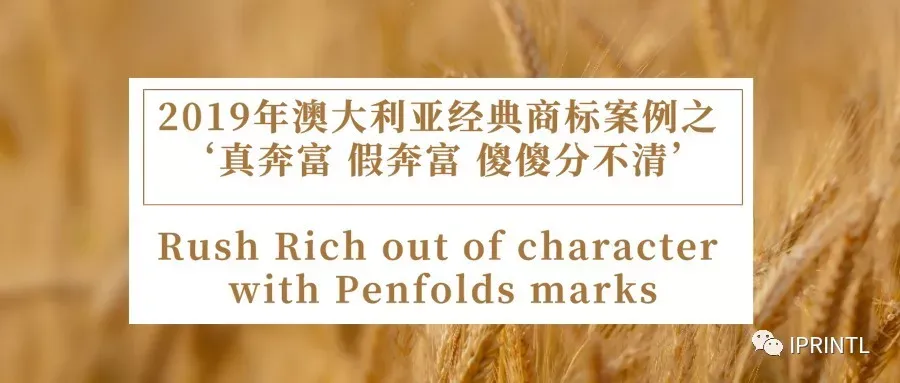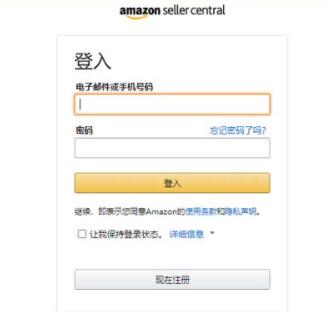各大跨境电商平台再出"抗疫"新政策


当事双方 Parties
作为富邑葡萄酒(以下简称为富邑)的子公司,南社布兰兹有限公司(以下简称为南杜)主要在澳洲以及海外生产,分销葡萄酒。针对富邑旗下的葡萄酒品牌,南杜持有诸多在澳注册商标,其中包括著名的奔富。而澳洲奔富酒园及其相关实体(以下统称为奔富酒庄)则是一家总部位于澳大利亚的酒厂,其主要经营范围包括在澳销售,并对华出口葡萄酒。
Southcorp Brands Pty Ltd (Southcorp) is a subsidiary of Treasury Wine Estates Ltd (TWE), which produces and distributes wine in Australia and overseas. Southcorp owns a large number of Australian trade mark registrations for various TWE wine brands, including the well-known Penfolds brand. Australia Rush Rich Winery Pty Ltd and its related entities (all together referred to as ARRW) comprise an Australian-based winery that sells wines in Australia and exports wines to China.
商标 Trade Marks
针对葡萄酒,南社申请注册并持有以下商标:
• 商标 37674 – Penfolds
• 商标 1762333 – BEN FU (拼音)
• 商标 1762317 - 奔富 (汉字)
而奔富酒庄则在其销售的酒的标签上使用下列汉字:
• 奔富;
• 奔富酒园;
• 奔富酒庄;
• 澳洲奔富酒庄
• 澳洲奔富 酒庄 (此为本文所讨论的争议商标)
背景信息及纠纷 Background and Issues
起初, 南杜公司应在华经销商建议,根据“奔富”的中文翻译,在1995年将其注册为汉字商标。而作为“奔富”的中文译文或等效,“奔富”这两字也被南杜所注册。原因在于: (1) 说普通话和粤语的人都会将汉字商标“奔富”读作“Bēn Fù”,而其拼音则写作“Bēn Fù”; (2) 在普通话和粤语中,“奔富”和“Penfolds”的发音都极为相似,除此以外,并无它例(3)正因于此,许多说普通话和粤语的人都将“PNEPUDS”直接称呼为“奔富”。
Southcorp initially adopted its Chinese Character Mark in 1995 as a Chinese translation of “Penfolds”, on the recommendation of its distributor in China. The Ben Fu Mark was also registered by Southcorp as a Chinese translation/equivalent of “Penfolds”. This was because: (a) the Chinese Character Mark is pronounced by Mandarin and Cantonese speakers as “Ben Fù” and is written as “Ben Fù” in pinyin (the Roman letter version of Chinese characters based on their pronunciation); (b) the pronunciation of the Chinese Character Mark and “Ben Fù” by Mandarin and Cantonese speakers is phonetically very similar to and approximates to “Penfolds”, which has no other equivalent in Mandarin or Cantonese; and (c) because of the above, many Mandarin and Cantonese speakers refer to the brand “Penfolds” as “Ben Fù”.
除此以外,“奔富”的汉字以及拼音商标也广泛用于书面和口头形式,以指代品牌。而奔富酒园则在其对内销售和对华出口的葡萄酒标签上均使用了前文所述处于争议的商标,而该商标便包含南杜公司所持有的“奔富”两字。至于商标内的其他汉字纯属于描述性质,对应的翻译不过为“酒厂”、“葡萄酒园”或“澳大利亚”。
The Chinese Character Mark and “Ben Fù” are also widely sed in written and verbal form to refer to the “Penfolds” brand. ARRW used the Disputed Marks on the labels of wines that it sold in Australia and exported to customers in China. All of the Disputed Marks wholly encompass the Chinese Character Mark owned by Southcorp. The other Chinese characters in the Disputed Marks are purely descriptive and translate to either “winery”, “wine park” or “Australia”.
依据1995年《商标法案》该法第120条第(1)款,若第三人使用的商标与在先注册商标实质性相同,或欺骗性相似,又或该使用商标与在先注册商标所指代商品类别存在联系,则该第三人侵犯商标行为成立。
Under s120(1) of the Trade Marks Act 1995 (the Act), a person infringes a registered trade mark if it uses as a trade mark a sign that is substantially identical with, or deceptively similar to, the trade mark in relation to the goods for which the trade mark is registered.
此外,该法第228条规定,若某商标在澳洲境内,或在澳洲出口相关商品上使用,则就本法而言,该商标在商品上的使用视为有效。
In addition, s228 of the Act provides that if a trade mark is applied in Australia to or in relation to goods that are to be exported from Australia, the application of the trade mark is deemed to constitute use of the trade mark in relation to those goods for the purposes of the Act.
就此,南杜宣称奔富酒园在其葡萄酒标签上使用争议商标的行为,均对南杜旗下商标构成侵权。而对此,尽管奔富酒园有机会予以答复,但它却一不委派法律代表,二不发表任何意见。
Southcorp alleged that use of the Disputed Marks by ARRW on its wine labels infringed each of the Southcorp Marks. ARRW did not appoint sufficient legal representation, nor did ARRW file any submissions despite being provided with opportunities to do so.
而法院审判侵权南杜商标案的关键要点便在于,上述争议商标: (1)是否与南杜商标存在实质性相同或欺骗性相似;以及 (2) 奔富酒园是否将其“作为商标”使用。
Key issues for the Court regarding Southcorp’s infringement claim were whether any of the Disputed Marks: (a) are substantially identical with, or deceptively similar to, the Southcorp Marks; and (b) were used by ARRW “as a trade mark”.
争议商标及相关市场评估
Assessment of the Disputed Marks and relevant market
鉴于争议商标为汉字商标,法院法官指出,在判定争议标记是否与南杜商标存有实质上相同或欺骗性相似,或判定争议商标在葡萄酒上的使用是否存在误导消费者混淆南杜商标时,商标的初始意义、发音、音译和意译均应予以考量。
Given that the Disputed Marks were Chinese characters, the Court (Beach J) noted it was important to consider the ordinary signification, pronunciation, transliteration and translation of the Disputed Marks in determining whether they are substantially identical with, or deceptively similar to, the Southcorp Marks and whether their use for wine was likely to deceive wine consumers considering the Southcorp Marks.
参考高院2014年第48号坎特雷拉兄弟有限公司起诉摩德纳贸易有限公司的判例时,法官对评估词语初始含义的方法进行阐述,并就确定争议商标向相关目标市场所传达含义的必要性予以肯定。换而言之,即评估争议商标的目标葡萄酒消费者如何解决该商标。在评估相关市场时,法官注意到以下“重要背景事实”:
• 葡萄酒消费者群体中包含众多说普通话和粤语人群;
• 截至2016年6月30日,约52.6万名澳籍居民在中国境内出生,而普通话是澳洲境内最常见的外语,而粤语位列第三;
• 2016年期间,从中国到澳洲的短期游客超过120万人次(相比2006年,增幅为284.1%),而从澳洲到中国的短期游客超过45万人次(相比2006年,增幅为80.6%);且
• 中国是澳大利亚葡萄酒行业最重要的出口市场,2017年对华出口葡萄酒总价值约为8.48亿美元(占葡萄酒出口总额的33%)。
Referring to the decision in Canterella Bros Pty Ltd v Modena Trading Pty Ltd [2014] HCA 48, in which the High Court discussed the approach for evaluating the ordinary signification of a word, Beach J confirmed that it was necessary to determine the meaning conveyed by the Disputed Marks to the relevant target market or, in other words, to assess how the Disputed Marks would be understood by wine consumers to which the products were targeted. In assessing the relevant market, Beach J noted the following “significant background facts”:
• consumers of wine include many Mandarin and Cantonese speakers;
• as at 30 June 2016, 526,000 Australian residents had been born in China, with Mandarin being the most common foreign language spoken at home and Cantonese the third most common;
• in 2016, there were over 1.2 million short term visitor arrivals to Australia from China (an increase of 284.1% since 2006) and more than 450,000 short term departures from Australia to China (an increase of 80.6% since 2006); and
• China is the most significant export market for the Australian wine industry – with the value of wine exports to China in 2017 being around $848 million (or 33% of total wine exports).
此外,南杜还提供证据用以表明说普通话和粤语客户群体对南杜以及富邑的重要性,包括:
• 2018财年上半年,富邑在亚洲的净销售收入为2.975亿美元;
• 2015到2016年度中23%的游客、2016到2017年度中26%的游客以及2017/2018年29%的游客来自中国;
• 在奔富马吉尔酒庄的全部游客比例中,约8%的游客为说普通话或粤语的澳洲居民
• 南杜公司聘请会说普通话和粤语的员工,在马吉尔酒庄提供普通话和粤语的单日观光,并在酒庄内贴以普通话标牌。
Southcorp also provided evidence of how important the Mandarin and Cantonese speaking customer base is to Southcorp and TWE, including:
• TWE net sales revenue of $297.5 million in Asia for the first half of the 2018 financial year;
• 23% of visitors in 2015/2016, 26% of visitors in 2016/2017 and 29% of visitors in 2017/2018 to Southcorp’s Magill Estate Cellar Door were from China;
• around 8% of all visitors were Australian residents speaking Mandarin or Cantonese; and
• Southcorp employs Mandarin and Cantonese speaking staff, runs daily tours in Mandarin and Cantonese and uses Mandarin signage at its Magill Estate.
法院还认为,在评估汉字标志的使用是否构成商标侵权和/或存有误导或欺骗相关消费者时,汉字的含义和发音以及汉字的外观和发音都应予以考虑。即使因争议商标而被误导或欺骗的潜在消费者仅限于说普通话和粤语的群体,误导和欺骗行为仍然成立。
The Court also noted that when assessing if the use of Chinese language marks constitutes trade mark infringement and/or is likely to mislead or deceive relevant consumers, emphasis should be placed on the meaning and pronunciation of the Chinese characters as well as considering the appearance and sound of those characters. Misleading and deceptive conduct could also be established even if the class of potential customers misled or deceived by use of the Disputed Marks was limited to Mandarin and Cantonese speakers only.
实质性相同和欺骗性相似
Substantial identity and deceptive similarity
法官认为,上述争议商标均与南杜公司的商标存在实质性相同或欺骗性相似。就南杜公司的汉字商标而言,原因在于:(1)所有争议商标中使用的两个汉字(即冲突汉字)在外观、声音和含义上都与注册汉字商标相同;(2)就其纯粹描述性质而言,所有争议中的指代“酒厂”,“葡萄酒园”或“澳洲”等剩余字符均可予以忽略(3)上述冲突汉字是奔富酒庄在其葡萄酒标签上所使用的前两个字符,并以粗体显示;(4)在评估欺骗性相似性时,复合商标的第一部分或单词通常予以优先考虑;(5)考虑到上述情况,与南杜的汉字商标相同的冲突字符不仅可用于判断其他争议商标,其本身还指示了带有争议商标产品的产地。
Justice Beach held that that the Disputed Marks were all substantially identical with or deceptively similar to the Southcorp marks. In the case of Southcorp’s Chinese Character Mark, this was on the basis that: (a) two of the Chinese characters used in all of the Disputed Marks (the Conflicting Characters) are identical to the Chinese Character Mark in appearance, sound and meaning; (b) the other characters in all of the Disputed Marks mean “winery”, “wine park” or “Australia” and may be discounted given that they are purely descriptive; (c) the Conflicting Characters were the first two characters used by ARRW on its wine labels and were displayed in bold font; (d) the first part or word/s of a composite mark are generally given prominence when assessing deceptive similarity; and (e) considering the above, the Conflicting Characters, which are identical to Southcorp’s Chinese Character Mark, were the dominant cognitive cue of each of the Disputed Marks and acted to indicate the origin of the products to which the Disputed Marks were applied.
尽管争议商标在外观方面与南杜的奔富商标并不相同或相似,法官仍认为争议商标与南杜的奔富商标存在实质性相同或欺骗性相似的嫌疑,原因在于:(1)冲突字符在普通话和粤语中的读与写均为“奔富”;(2)冲突字符“奔富”的使用,实质上是商标的“整体听觉再现”;(3)在说普通话和粤语的消费者对奔富商标认知不完备的情形下,存在其混淆贴有争议商标的葡萄酒是否与贴有奔富商标的葡萄酒来自相同产地的来源相同的风险。
Even though the appearance of the Disputed Marks was not identical with or similar to the Ben Fu Mark, Beach J took the view that the Disputed Marks were still either substantially identical with or deceptively similar to the Ben Fu Mark because: (a) the Conflicting Characters are pronounced and written by Mandarin and Cantonese speakers as “Ben Fu”; (b) use of the Conflicting Characters is effectively a “wholesale aural reproduction” of the Ben Fu Mark; and (c) there is a tangible danger that Mandarin and Cantonese speakers with imperfect recollection of the Ben Fu Mark would wonder whether wines labelled with the Disputed Marks were from the same source as wines branded with the Ben Fu Mark.
相类似地,其他争议商标也都与奔富存在实质上相同或欺骗性相似的嫌疑。法官还认为,如果普通话和粤语的葡萄酒消费者群体对奔富商标认知不完备,这些争议商标的使用可能欺骗或混淆上述消费者群体。特别是考虑到:(1)争议商标主要针对说普通话和粤语的葡萄酒消费者群体;(2)冲突字符的发音为“Ben Fu”;(3)“Ben Fu”在发音上非常近似于“Penfolds”;(d)对普通话和粤语的葡萄酒消费者群体而言,争议商标的含义通常是“奔富酒庄”、“奔富酒园”或“澳大利亚奔富酒庄”。
Each of the Disputed Marks was again held to be either substantially identical with or deceptively similar to
the Penfolds Mark. Justice Beach also held that use of the Disputed Marks would likely deceive or confuse Mandarin and Cantonese speaking wine consumers with an imperfect recollection of the Penfolds Mark. This is especially the case given that: (a) the Disputed Marks were targeted at Mandarin and Cantonese speaking wine consumers; (b) the Conflicting Characters are pronounced by such consumers as “Ben Fu”; (c) “Ben Fu” is phonetically very similar to and approximates to “Penfolds”; and (d) the meaning of the Disputed Marks to Mandarin and Cantonese speaking wine consumers would generally be “Penfolds Winery”, “Penfolds Wine Park” or “Australia Penfolds Winery”.
而且下述的各项行为还表明奔富酒园在使用争议商标时,存有盗用“奔富”品牌声誉和/或误导说普通话和粤语的葡萄酒消费者的意图。这些行为包括:(1)经营使用英文单词“Penfolds”并复制富邑酿酒商图片的网站;(2)经营印有奔富酒园标志的网店,但实质上却使用了马吉尔酒庄的照片和“洛神山庄”字样(南杜所持有的另一枚澳洲商标);以及(3)提供带有类似奔富葡萄酒标签的瓶装葡萄酒。据此,法院认为,奔富酒园对相关争议商标的使用,其背后存有欺骗或混淆的明显意图。且法院有理由相信,奔富酒园的相关意图会赴以实践。
Certain conduct also suggested that ARRW used the Disputed Marks with the intention of misappropriating the reputation of the “Penfolds” brand and/or misleading Mandarin and Cantonese speaking wine consumers. This conduct included: (a) operating a website that used the English word “Penfolds” and copied images of TWE’s winemakers; (b) operating an online store that featured ARRW’s “Rush Rich” logo, but with a photo of the Magill Estate and the words “Rawson’s Retreat” (which is another Australian trade mark owned by Southcorp); and (c) offering for sale bottles of wine with labels that appeared to mimic the labels of certain Penfolds-branded wines. The Court considered that ARRW’s apparent intention behind using the Disputed Marks was a relevant consideration and that, in circumstances where it is apparent that such use was made with the intention of deceiving or confusing, it is open to the Court to decide that such use is likely to do so.
作为商标的使用 Use "as a trade mark"
即便某一商标与在先注册商标存在实质性相同或具有欺骗性相似,侵权行为也仅在该商标被作为商标所使用的情形下(如用于指明有关商品或服务的来源或原产地)才发生。正如法官所言,问题的关键便在于在消费者看来,争议商标“是否具有品牌特征”。
在审查奔富酒园使用争议商标的相关证据之后,法官认定奔富酒园确将争议商标用作商标。法官得出这一结论,原因在于:
• 在葡萄酒标签上以粗体文本居中使用“奔富酒园”和“澳洲大利亚奔富 酒庄” 等字;
• 在上述字符后立即使用®符号-意在向客户表明其为商标;
• 申请注册“奔富”、“奔富酒园”和“奔富酒庄”为葡萄酒商标。若没有相关使用意图,则奔富酒园不会进行申请操作;
• 在葡萄酒标签上的“生产者”字样后随即使用“澳大利亚奔富酒庄”,意在向客户表明葡萄酒由由“澳大利亚奔富酒庄”所生产的;以及
• 将争议商标贴在带有酒厂信息的葡萄酒标签上。
Even if a sign is substantially identical with, or deceptively similar to, a registered trade mark, infringement will only occur if that sign is used as a trade mark (i.e. for the purpose of indicating the source or origin of the relevant goods or services). As put by Beach J, the question is whether the Disputed Marks “would appear to consumers as possessing the character of the brand”.
After reviewing evidence of how the Disputed Marks had been used by ARRW, Beach J was of no doubt that ARRW had used the Disputed Marks as trade marks. Justice Beach reached this conclusion because ARRW:
• used 奔富酒园 and 澳洲大利亚奔富 酒庄 in bold text centred text on its wine labels;
• used the ® symbol immediately after the above characters – clearly indicating to customers that they are functioning as trade marks;
• applied to register 奔富, 奔富酒园 and 奔富酒庄 as trade marks for wine, which ARRW would not do if it were not using those characters as trade marks;
• used 澳大利亚奔富酒庄 (“Australia Penfolds Winery”) on its wine labels immediately after the Chinese characters for “Producer” – indicating to customers that the wines were produced by “Australian Penfolds Winery”;
• and placed the Disputed Marks on its wine labels in positions where information about wineries is typically included on wine labels.
除此以外,依上述《商标法》第228条,对华出口的酒瓶上使用争议商标应被视为商标使用。据此,法院认定奔富酒园在争议商标的使用构成对南杜商标的侵权行为。法院判奔富酒园:(1)立即停止使用相关争议商标;(2)撤销其有关争议商标的商标申请;(3)向南杜公司支付375302.34美元,作为使用争议商标的不当得利;以及(4)支付南杜公司的相关诉讼费用。
In addition to the above, application of the Disputed Marks to wine bottles for export to China is clearly deemed to be trade mark use under s228 of the Act. As a result, the Court held that use of the Disputed Marks by ARRW infringed the Southcorp Marks. The Court ordered ARRW to: (a) cease use of the Disputed Marks; (b) withdraw its trade mark applications for the relevant Disputed Marks; (c) pay Southcorp $375,302.34 as an account of profits attributed to use of the Disputed Marks; and (d) pay Southcorp’s legal costs.
本文译自 Shelston IP (澳大利亚骁盾知识产权事务所), 作者为本所Michael Deacon (合伙人),翻译为中国五洲普华国际部Vincent。

我们建了一个亚马逊卖家交流群,里面不乏很多大卖家。
现在扫码回复“ 加群 ”,拉你进群。
热门文章
*30分钟更新一次































